Aviation System Report: Factors, Models, and Design Analysis
VerifiedAdded on 2023/01/19
|15
|2876
|78
Report
AI Summary
This report provides a detailed analysis of the aviation system, covering various aspects from key factors influencing airline and airport operations to the significance of the Chicago Convention and the concept of Aerotropolis. It delves into the roles of airside design, ground handling services, and different airline models, including the Full-Service Network Carrier (FSNC) and Low-Cost Carrier (LCC). The report also explores airport business models, airfield design considerations, and the importance of airport master planning, along with the stakeholders involved. Additionally, it discusses the impact of annexes on global security and the management of aviation security, concluding with an overview of the aviation system's components and operational procedures.

THE AVIATION SYSTEM 1
THE AVIATION SYSTEM
By (name)
The name of course
Tutor’s name
The name of the university
The country and the city where it’s located
Date
THE AVIATION SYSTEM
By (name)
The name of course
Tutor’s name
The name of the university
The country and the city where it’s located
Date
Paraphrase This Document
Need a fresh take? Get an instant paraphrase of this document with our AI Paraphraser
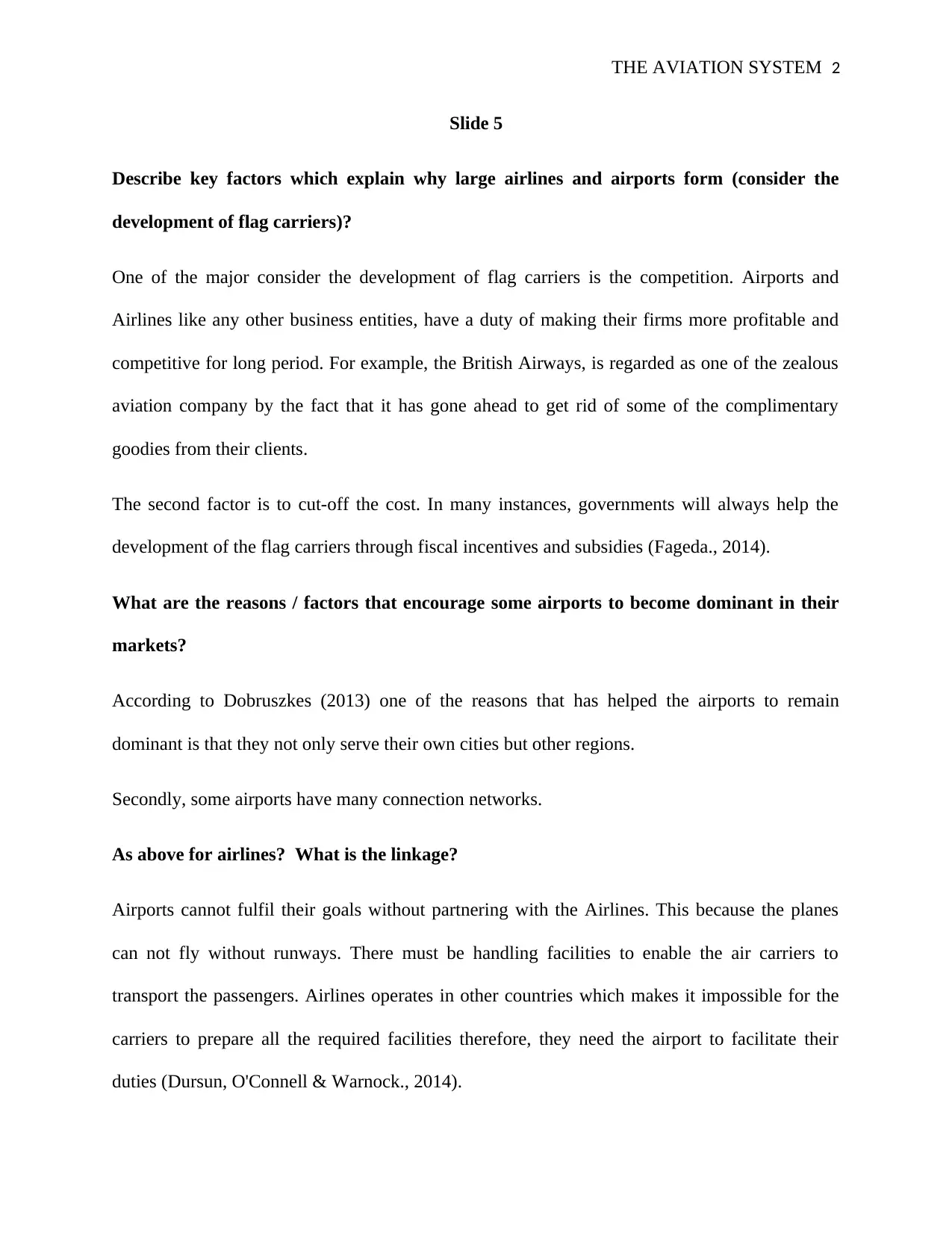
THE AVIATION SYSTEM 2
Slide 5
Describe key factors which explain why large airlines and airports form (consider the
development of flag carriers)?
One of the major consider the development of flag carriers is the competition. Airports and
Airlines like any other business entities, have a duty of making their firms more profitable and
competitive for long period. For example, the British Airways, is regarded as one of the zealous
aviation company by the fact that it has gone ahead to get rid of some of the complimentary
goodies from their clients.
The second factor is to cut-off the cost. In many instances, governments will always help the
development of the flag carriers through fiscal incentives and subsidies (Fageda., 2014).
What are the reasons / factors that encourage some airports to become dominant in their
markets?
According to Dobruszkes (2013) one of the reasons that has helped the airports to remain
dominant is that they not only serve their own cities but other regions.
Secondly, some airports have many connection networks.
As above for airlines? What is the linkage?
Airports cannot fulfil their goals without partnering with the Airlines. This because the planes
can not fly without runways. There must be handling facilities to enable the air carriers to
transport the passengers. Airlines operates in other countries which makes it impossible for the
carriers to prepare all the required facilities therefore, they need the airport to facilitate their
duties (Dursun, O'Connell & Warnock., 2014).
Slide 5
Describe key factors which explain why large airlines and airports form (consider the
development of flag carriers)?
One of the major consider the development of flag carriers is the competition. Airports and
Airlines like any other business entities, have a duty of making their firms more profitable and
competitive for long period. For example, the British Airways, is regarded as one of the zealous
aviation company by the fact that it has gone ahead to get rid of some of the complimentary
goodies from their clients.
The second factor is to cut-off the cost. In many instances, governments will always help the
development of the flag carriers through fiscal incentives and subsidies (Fageda., 2014).
What are the reasons / factors that encourage some airports to become dominant in their
markets?
According to Dobruszkes (2013) one of the reasons that has helped the airports to remain
dominant is that they not only serve their own cities but other regions.
Secondly, some airports have many connection networks.
As above for airlines? What is the linkage?
Airports cannot fulfil their goals without partnering with the Airlines. This because the planes
can not fly without runways. There must be handling facilities to enable the air carriers to
transport the passengers. Airlines operates in other countries which makes it impossible for the
carriers to prepare all the required facilities therefore, they need the airport to facilitate their
duties (Dursun, O'Connell & Warnock., 2014).
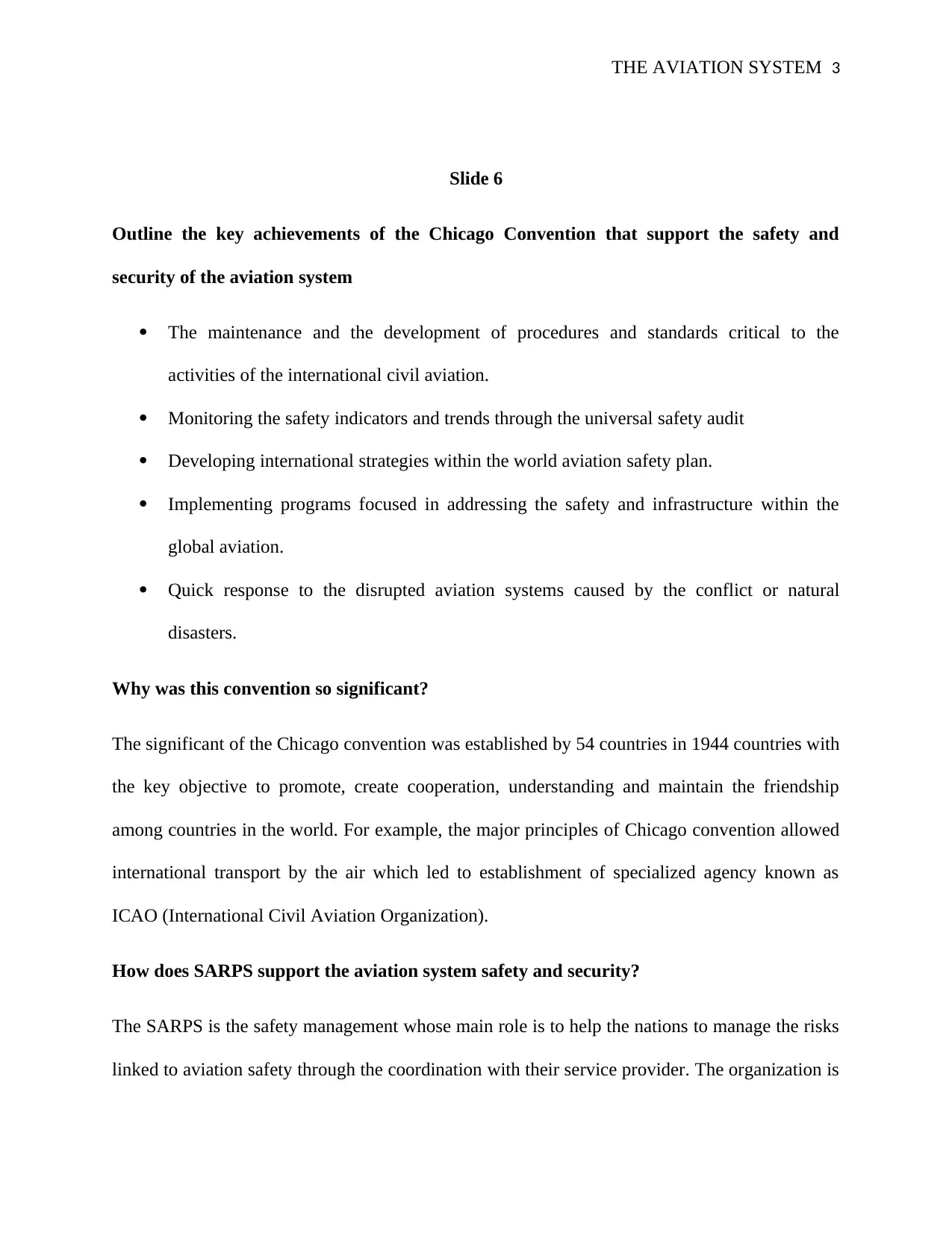
THE AVIATION SYSTEM 3
Slide 6
Outline the key achievements of the Chicago Convention that support the safety and
security of the aviation system
The maintenance and the development of procedures and standards critical to the
activities of the international civil aviation.
Monitoring the safety indicators and trends through the universal safety audit
Developing international strategies within the world aviation safety plan.
Implementing programs focused in addressing the safety and infrastructure within the
global aviation.
Quick response to the disrupted aviation systems caused by the conflict or natural
disasters.
Why was this convention so significant?
The significant of the Chicago convention was established by 54 countries in 1944 countries with
the key objective to promote, create cooperation, understanding and maintain the friendship
among countries in the world. For example, the major principles of Chicago convention allowed
international transport by the air which led to establishment of specialized agency known as
ICAO (International Civil Aviation Organization).
How does SARPS support the aviation system safety and security?
The SARPS is the safety management whose main role is to help the nations to manage the risks
linked to aviation safety through the coordination with their service provider. The organization is
Slide 6
Outline the key achievements of the Chicago Convention that support the safety and
security of the aviation system
The maintenance and the development of procedures and standards critical to the
activities of the international civil aviation.
Monitoring the safety indicators and trends through the universal safety audit
Developing international strategies within the world aviation safety plan.
Implementing programs focused in addressing the safety and infrastructure within the
global aviation.
Quick response to the disrupted aviation systems caused by the conflict or natural
disasters.
Why was this convention so significant?
The significant of the Chicago convention was established by 54 countries in 1944 countries with
the key objective to promote, create cooperation, understanding and maintain the friendship
among countries in the world. For example, the major principles of Chicago convention allowed
international transport by the air which led to establishment of specialized agency known as
ICAO (International Civil Aviation Organization).
How does SARPS support the aviation system safety and security?
The SARPS is the safety management whose main role is to help the nations to manage the risks
linked to aviation safety through the coordination with their service provider. The organization is
⊘ This is a preview!⊘
Do you want full access?
Subscribe today to unlock all pages.

Trusted by 1+ million students worldwide
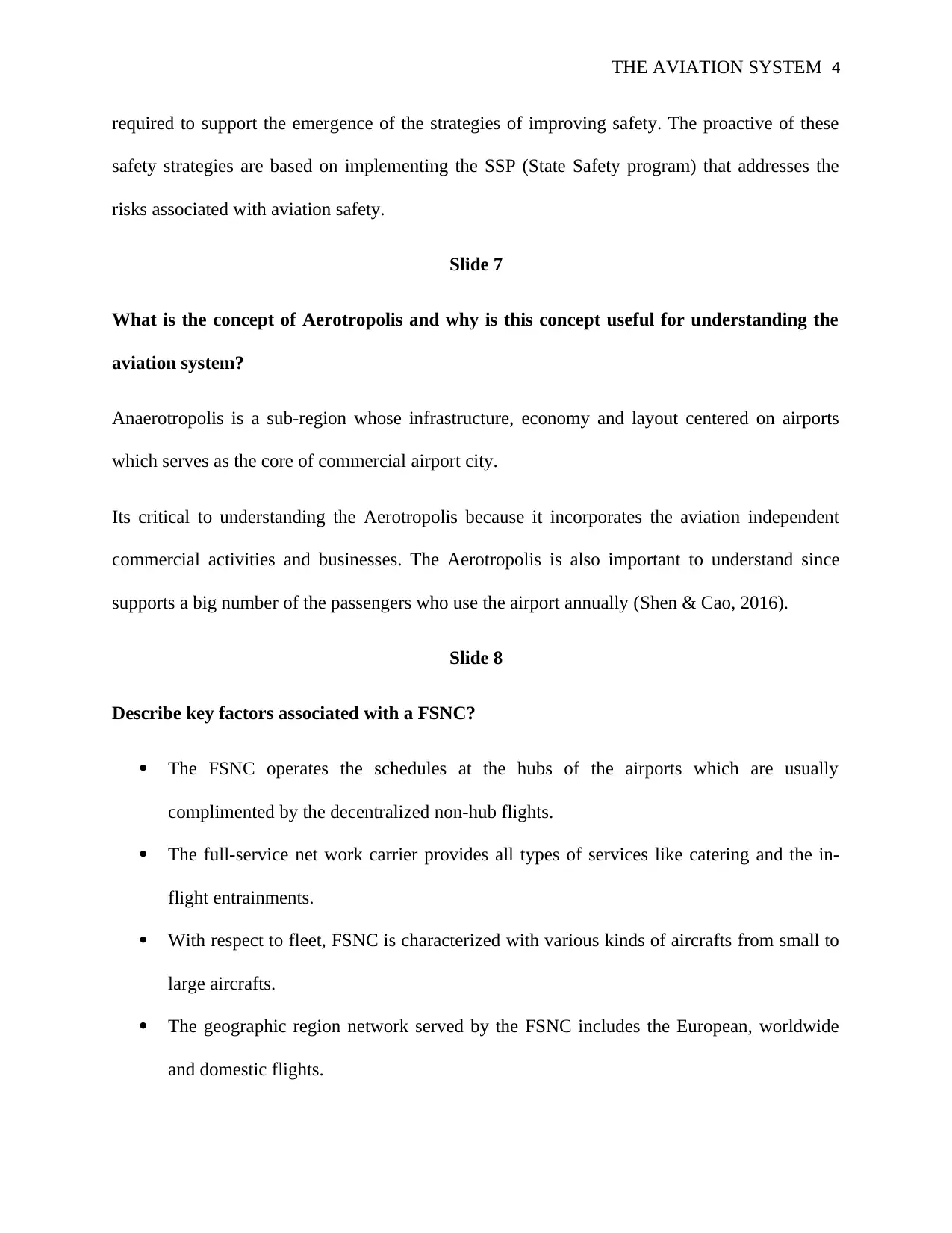
THE AVIATION SYSTEM 4
required to support the emergence of the strategies of improving safety. The proactive of these
safety strategies are based on implementing the SSP (State Safety program) that addresses the
risks associated with aviation safety.
Slide 7
What is the concept of Aerotropolis and why is this concept useful for understanding the
aviation system?
Anaerotropolis is a sub-region whose infrastructure, economy and layout centered on airports
which serves as the core of commercial airport city.
Its critical to understanding the Aerotropolis because it incorporates the aviation independent
commercial activities and businesses. The Aerotropolis is also important to understand since
supports a big number of the passengers who use the airport annually (Shen & Cao, 2016).
Slide 8
Describe key factors associated with a FSNC?
The FSNC operates the schedules at the hubs of the airports which are usually
complimented by the decentralized non-hub flights.
The full-service net work carrier provides all types of services like catering and the in-
flight entrainments.
With respect to fleet, FSNC is characterized with various kinds of aircrafts from small to
large aircrafts.
The geographic region network served by the FSNC includes the European, worldwide
and domestic flights.
required to support the emergence of the strategies of improving safety. The proactive of these
safety strategies are based on implementing the SSP (State Safety program) that addresses the
risks associated with aviation safety.
Slide 7
What is the concept of Aerotropolis and why is this concept useful for understanding the
aviation system?
Anaerotropolis is a sub-region whose infrastructure, economy and layout centered on airports
which serves as the core of commercial airport city.
Its critical to understanding the Aerotropolis because it incorporates the aviation independent
commercial activities and businesses. The Aerotropolis is also important to understand since
supports a big number of the passengers who use the airport annually (Shen & Cao, 2016).
Slide 8
Describe key factors associated with a FSNC?
The FSNC operates the schedules at the hubs of the airports which are usually
complimented by the decentralized non-hub flights.
The full-service net work carrier provides all types of services like catering and the in-
flight entrainments.
With respect to fleet, FSNC is characterized with various kinds of aircrafts from small to
large aircrafts.
The geographic region network served by the FSNC includes the European, worldwide
and domestic flights.
Paraphrase This Document
Need a fresh take? Get an instant paraphrase of this document with our AI Paraphraser

THE AVIATION SYSTEM 5
The schedules for FSNCs are also are of both destinations and origin which are provided
through perspective hubs and with a higher frequency.
What is the definition of a Full-Service Network Carrier?
The full-service Network carrier is a scheduled airline with a business technique that set to offer
an extensive and diverse services
Why is this type of airline so important to understand?
It is important to understand this type of airline because FSNC is key in accessing the global
destinations which can be connected through national gateway airport.
What are the factors that support this type of airline?
The airline is network-oriented with more than one hub.
The airline covers a large geographical region and has a variety of classes.
The airline provides low cost for the flights that operate on medium and short routes
(Acar &Karabulak, 2015).
Slide 9
Describe factors linked to airside design that allow airlines to operate safely and securely?
A good security plan to play a key role in assessing the possible vulnerabilities at new sites and
facilities.
Implementing procedures that incorporate the positive, orderly and immediate actions to safe
lives and properties in case of an emergency.
The schedules for FSNCs are also are of both destinations and origin which are provided
through perspective hubs and with a higher frequency.
What is the definition of a Full-Service Network Carrier?
The full-service Network carrier is a scheduled airline with a business technique that set to offer
an extensive and diverse services
Why is this type of airline so important to understand?
It is important to understand this type of airline because FSNC is key in accessing the global
destinations which can be connected through national gateway airport.
What are the factors that support this type of airline?
The airline is network-oriented with more than one hub.
The airline covers a large geographical region and has a variety of classes.
The airline provides low cost for the flights that operate on medium and short routes
(Acar &Karabulak, 2015).
Slide 9
Describe factors linked to airside design that allow airlines to operate safely and securely?
A good security plan to play a key role in assessing the possible vulnerabilities at new sites and
facilities.
Implementing procedures that incorporate the positive, orderly and immediate actions to safe
lives and properties in case of an emergency.
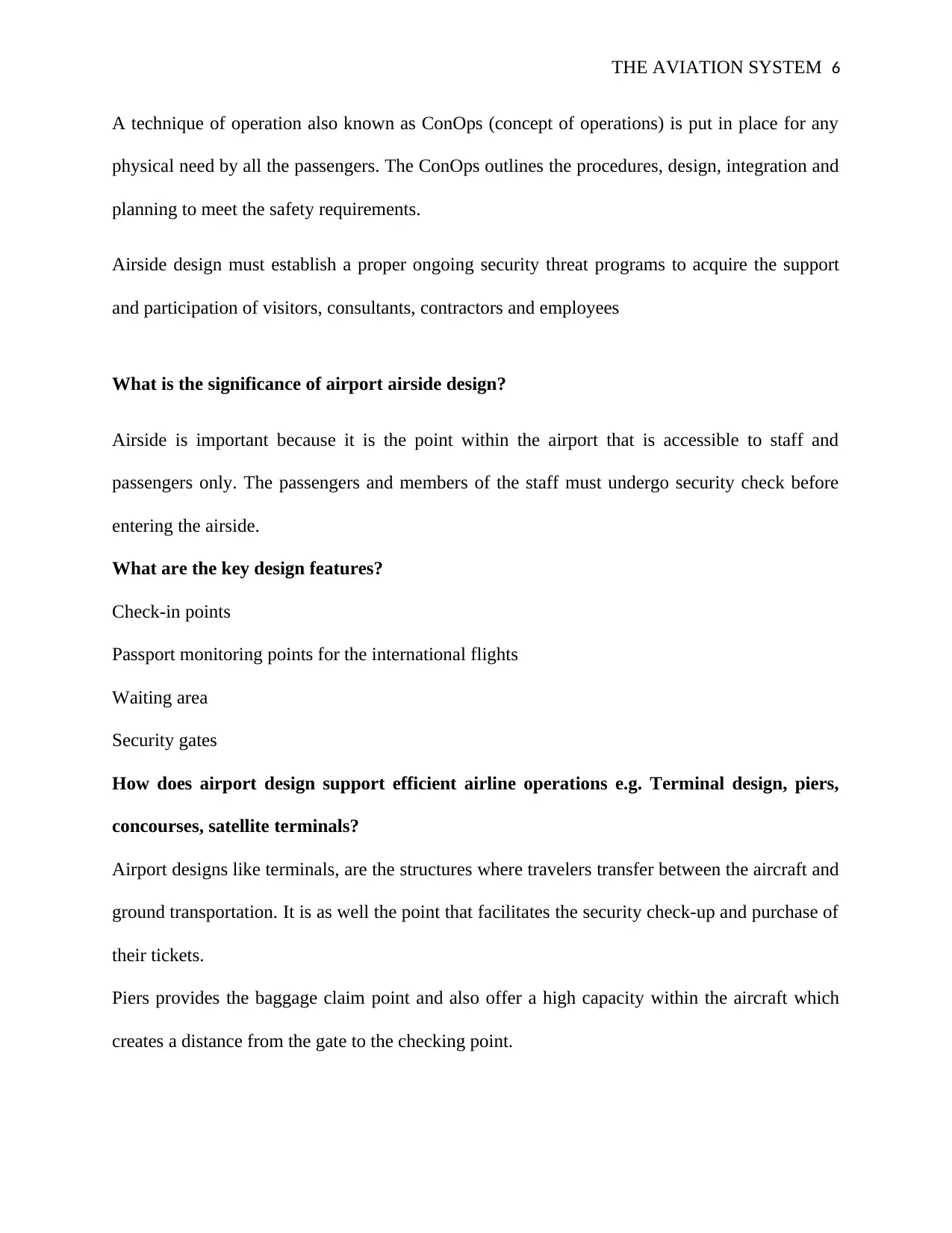
THE AVIATION SYSTEM 6
A technique of operation also known as ConOps (concept of operations) is put in place for any
physical need by all the passengers. The ConOps outlines the procedures, design, integration and
planning to meet the safety requirements.
Airside design must establish a proper ongoing security threat programs to acquire the support
and participation of visitors, consultants, contractors and employees
What is the significance of airport airside design?
Airside is important because it is the point within the airport that is accessible to staff and
passengers only. The passengers and members of the staff must undergo security check before
entering the airside.
What are the key design features?
Check-in points
Passport monitoring points for the international flights
Waiting area
Security gates
How does airport design support efficient airline operations e.g. Terminal design, piers,
concourses, satellite terminals?
Airport designs like terminals, are the structures where travelers transfer between the aircraft and
ground transportation. It is as well the point that facilitates the security check-up and purchase of
their tickets.
Piers provides the baggage claim point and also offer a high capacity within the aircraft which
creates a distance from the gate to the checking point.
A technique of operation also known as ConOps (concept of operations) is put in place for any
physical need by all the passengers. The ConOps outlines the procedures, design, integration and
planning to meet the safety requirements.
Airside design must establish a proper ongoing security threat programs to acquire the support
and participation of visitors, consultants, contractors and employees
What is the significance of airport airside design?
Airside is important because it is the point within the airport that is accessible to staff and
passengers only. The passengers and members of the staff must undergo security check before
entering the airside.
What are the key design features?
Check-in points
Passport monitoring points for the international flights
Waiting area
Security gates
How does airport design support efficient airline operations e.g. Terminal design, piers,
concourses, satellite terminals?
Airport designs like terminals, are the structures where travelers transfer between the aircraft and
ground transportation. It is as well the point that facilitates the security check-up and purchase of
their tickets.
Piers provides the baggage claim point and also offer a high capacity within the aircraft which
creates a distance from the gate to the checking point.
⊘ This is a preview!⊘
Do you want full access?
Subscribe today to unlock all pages.

Trusted by 1+ million students worldwide

THE AVIATION SYSTEM 7
Satellite terminal offer the parking for the aircraft and used as a pedestrian tunnel by the
passengers.
Slide 10
What is the role of ground handling services in the aviation system?
One of the services at the groundling is providing the parking point for the plane
The next role is the pint where agents are handled
Its also a point where the maintenances of the craft are done.
What is ground handling – definition
The ground handling is the serving of the aircraft while parked at the terminal gate of the airport.
How does GH support the aviation system?
Ground handling support the aviation system by addressing needs of airliner during the arrival
and the departure time. Among the services offered through ground handling include the
efficiency, accuracy and speed which help in reducing the turnaround.
What types services are supported by ground handling companies?
Catering like loading the fresh foods
Passenger services like offering the departure and arrival services
Field operations like communicating with the airline within the airport.
Cabin services like ensuring the travellers are comfortable (Marintseva, Yun & Kachur, 2015).
Satellite terminal offer the parking for the aircraft and used as a pedestrian tunnel by the
passengers.
Slide 10
What is the role of ground handling services in the aviation system?
One of the services at the groundling is providing the parking point for the plane
The next role is the pint where agents are handled
Its also a point where the maintenances of the craft are done.
What is ground handling – definition
The ground handling is the serving of the aircraft while parked at the terminal gate of the airport.
How does GH support the aviation system?
Ground handling support the aviation system by addressing needs of airliner during the arrival
and the departure time. Among the services offered through ground handling include the
efficiency, accuracy and speed which help in reducing the turnaround.
What types services are supported by ground handling companies?
Catering like loading the fresh foods
Passenger services like offering the departure and arrival services
Field operations like communicating with the airline within the airport.
Cabin services like ensuring the travellers are comfortable (Marintseva, Yun & Kachur, 2015).
Paraphrase This Document
Need a fresh take? Get an instant paraphrase of this document with our AI Paraphraser

THE AVIATION SYSTEM 8
Slide 11
What are the different types of airlines models?
LCC (low cost carrier) model
Network line models
Ultra-low-cost airline models
What are the key features of one of the following types of business models?
Low cost carrier
Has a higher seat density.
Has fast turnaround periods.
Has the homogenous fleets.
Operates in both regional and secondary airports.
Low cost barrier has the direct and online distribution of their flight tickets.
Slide 12
What are the different types of airport business models and why do a small number of
airports become dominant?
Long haul
Hub airport
Charter and low-cost airport
Regional carrier
Slide 11
What are the different types of airlines models?
LCC (low cost carrier) model
Network line models
Ultra-low-cost airline models
What are the key features of one of the following types of business models?
Low cost carrier
Has a higher seat density.
Has fast turnaround periods.
Has the homogenous fleets.
Operates in both regional and secondary airports.
Low cost barrier has the direct and online distribution of their flight tickets.
Slide 12
What are the different types of airport business models and why do a small number of
airports become dominant?
Long haul
Hub airport
Charter and low-cost airport
Regional carrier
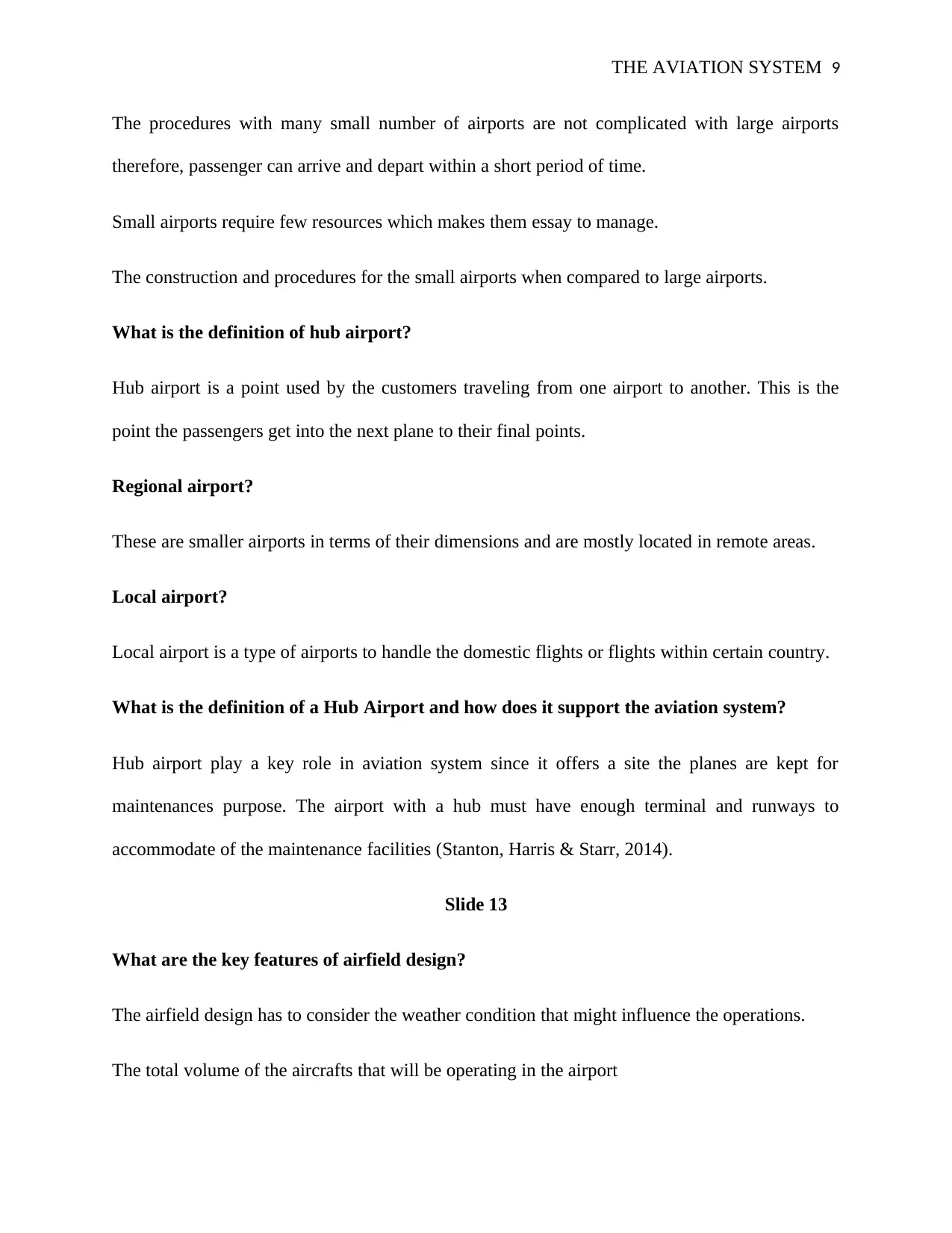
THE AVIATION SYSTEM 9
The procedures with many small number of airports are not complicated with large airports
therefore, passenger can arrive and depart within a short period of time.
Small airports require few resources which makes them essay to manage.
The construction and procedures for the small airports when compared to large airports.
What is the definition of hub airport?
Hub airport is a point used by the customers traveling from one airport to another. This is the
point the passengers get into the next plane to their final points.
Regional airport?
These are smaller airports in terms of their dimensions and are mostly located in remote areas.
Local airport?
Local airport is a type of airports to handle the domestic flights or flights within certain country.
What is the definition of a Hub Airport and how does it support the aviation system?
Hub airport play a key role in aviation system since it offers a site the planes are kept for
maintenances purpose. The airport with a hub must have enough terminal and runways to
accommodate of the maintenance facilities (Stanton, Harris & Starr, 2014).
Slide 13
What are the key features of airfield design?
The airfield design has to consider the weather condition that might influence the operations.
The total volume of the aircrafts that will be operating in the airport
The procedures with many small number of airports are not complicated with large airports
therefore, passenger can arrive and depart within a short period of time.
Small airports require few resources which makes them essay to manage.
The construction and procedures for the small airports when compared to large airports.
What is the definition of hub airport?
Hub airport is a point used by the customers traveling from one airport to another. This is the
point the passengers get into the next plane to their final points.
Regional airport?
These are smaller airports in terms of their dimensions and are mostly located in remote areas.
Local airport?
Local airport is a type of airports to handle the domestic flights or flights within certain country.
What is the definition of a Hub Airport and how does it support the aviation system?
Hub airport play a key role in aviation system since it offers a site the planes are kept for
maintenances purpose. The airport with a hub must have enough terminal and runways to
accommodate of the maintenance facilities (Stanton, Harris & Starr, 2014).
Slide 13
What are the key features of airfield design?
The airfield design has to consider the weather condition that might influence the operations.
The total volume of the aircrafts that will be operating in the airport
⊘ This is a preview!⊘
Do you want full access?
Subscribe today to unlock all pages.

Trusted by 1+ million students worldwide
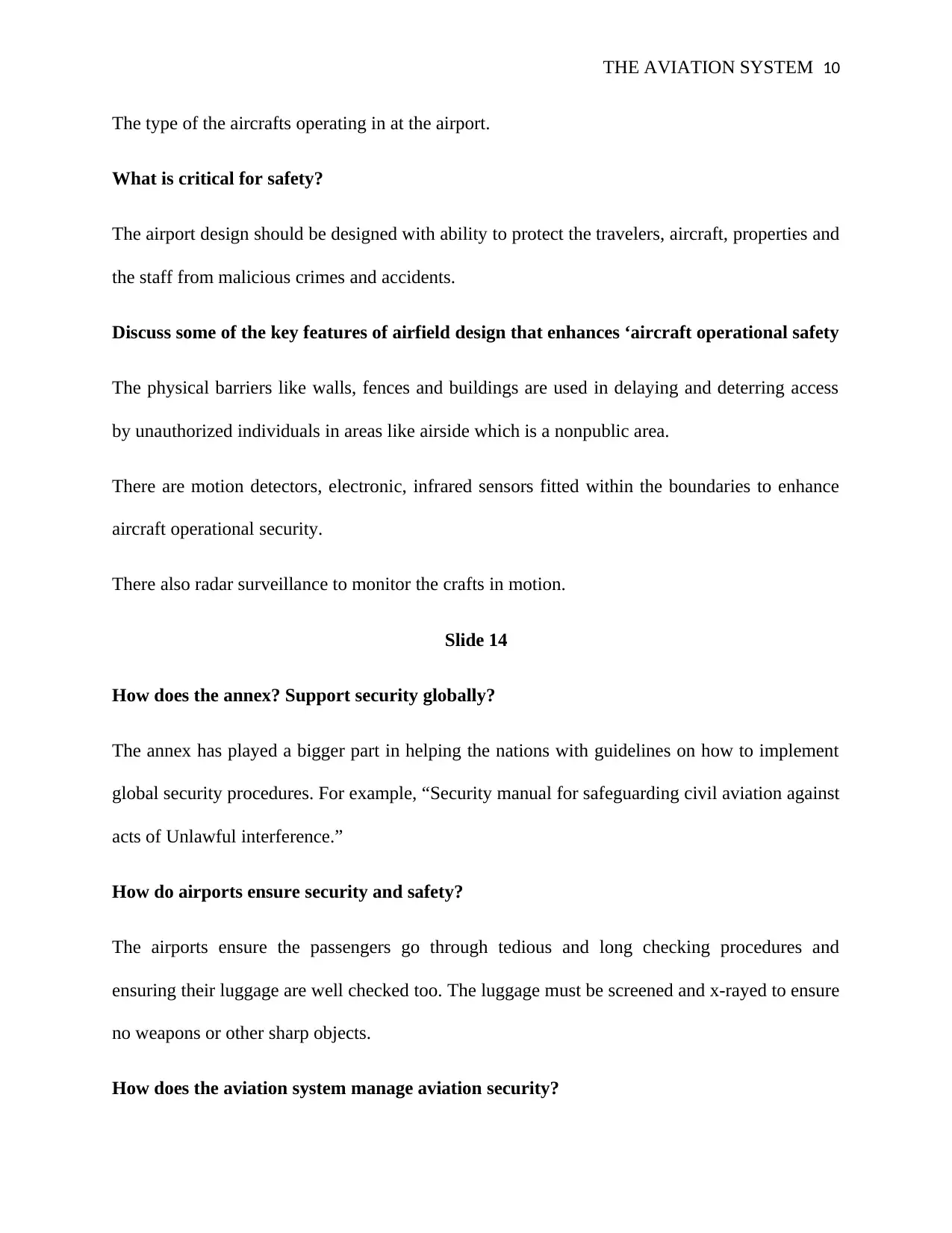
THE AVIATION SYSTEM 10
The type of the aircrafts operating in at the airport.
What is critical for safety?
The airport design should be designed with ability to protect the travelers, aircraft, properties and
the staff from malicious crimes and accidents.
Discuss some of the key features of airfield design that enhances ‘aircraft operational safety
The physical barriers like walls, fences and buildings are used in delaying and deterring access
by unauthorized individuals in areas like airside which is a nonpublic area.
There are motion detectors, electronic, infrared sensors fitted within the boundaries to enhance
aircraft operational security.
There also radar surveillance to monitor the crafts in motion.
Slide 14
How does the annex? Support security globally?
The annex has played a bigger part in helping the nations with guidelines on how to implement
global security procedures. For example, “Security manual for safeguarding civil aviation against
acts of Unlawful interference.”
How do airports ensure security and safety?
The airports ensure the passengers go through tedious and long checking procedures and
ensuring their luggage are well checked too. The luggage must be screened and x-rayed to ensure
no weapons or other sharp objects.
How does the aviation system manage aviation security?
The type of the aircrafts operating in at the airport.
What is critical for safety?
The airport design should be designed with ability to protect the travelers, aircraft, properties and
the staff from malicious crimes and accidents.
Discuss some of the key features of airfield design that enhances ‘aircraft operational safety
The physical barriers like walls, fences and buildings are used in delaying and deterring access
by unauthorized individuals in areas like airside which is a nonpublic area.
There are motion detectors, electronic, infrared sensors fitted within the boundaries to enhance
aircraft operational security.
There also radar surveillance to monitor the crafts in motion.
Slide 14
How does the annex? Support security globally?
The annex has played a bigger part in helping the nations with guidelines on how to implement
global security procedures. For example, “Security manual for safeguarding civil aviation against
acts of Unlawful interference.”
How do airports ensure security and safety?
The airports ensure the passengers go through tedious and long checking procedures and
ensuring their luggage are well checked too. The luggage must be screened and x-rayed to ensure
no weapons or other sharp objects.
How does the aviation system manage aviation security?
Paraphrase This Document
Need a fresh take? Get an instant paraphrase of this document with our AI Paraphraser
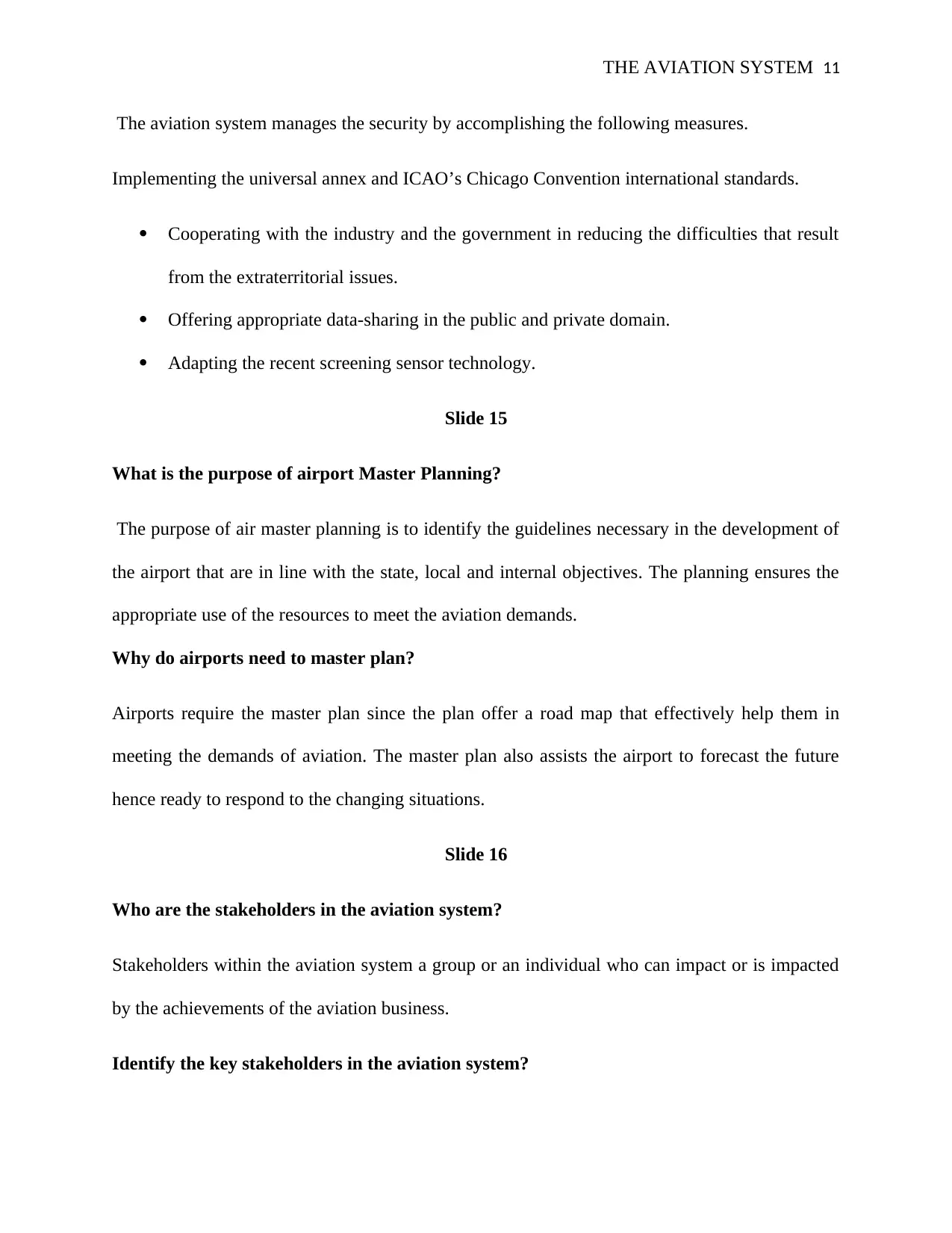
THE AVIATION SYSTEM 11
The aviation system manages the security by accomplishing the following measures.
Implementing the universal annex and ICAO’s Chicago Convention international standards.
Cooperating with the industry and the government in reducing the difficulties that result
from the extraterritorial issues.
Offering appropriate data-sharing in the public and private domain.
Adapting the recent screening sensor technology.
Slide 15
What is the purpose of airport Master Planning?
The purpose of air master planning is to identify the guidelines necessary in the development of
the airport that are in line with the state, local and internal objectives. The planning ensures the
appropriate use of the resources to meet the aviation demands.
Why do airports need to master plan?
Airports require the master plan since the plan offer a road map that effectively help them in
meeting the demands of aviation. The master plan also assists the airport to forecast the future
hence ready to respond to the changing situations.
Slide 16
Who are the stakeholders in the aviation system?
Stakeholders within the aviation system a group or an individual who can impact or is impacted
by the achievements of the aviation business.
Identify the key stakeholders in the aviation system?
The aviation system manages the security by accomplishing the following measures.
Implementing the universal annex and ICAO’s Chicago Convention international standards.
Cooperating with the industry and the government in reducing the difficulties that result
from the extraterritorial issues.
Offering appropriate data-sharing in the public and private domain.
Adapting the recent screening sensor technology.
Slide 15
What is the purpose of airport Master Planning?
The purpose of air master planning is to identify the guidelines necessary in the development of
the airport that are in line with the state, local and internal objectives. The planning ensures the
appropriate use of the resources to meet the aviation demands.
Why do airports need to master plan?
Airports require the master plan since the plan offer a road map that effectively help them in
meeting the demands of aviation. The master plan also assists the airport to forecast the future
hence ready to respond to the changing situations.
Slide 16
Who are the stakeholders in the aviation system?
Stakeholders within the aviation system a group or an individual who can impact or is impacted
by the achievements of the aviation business.
Identify the key stakeholders in the aviation system?
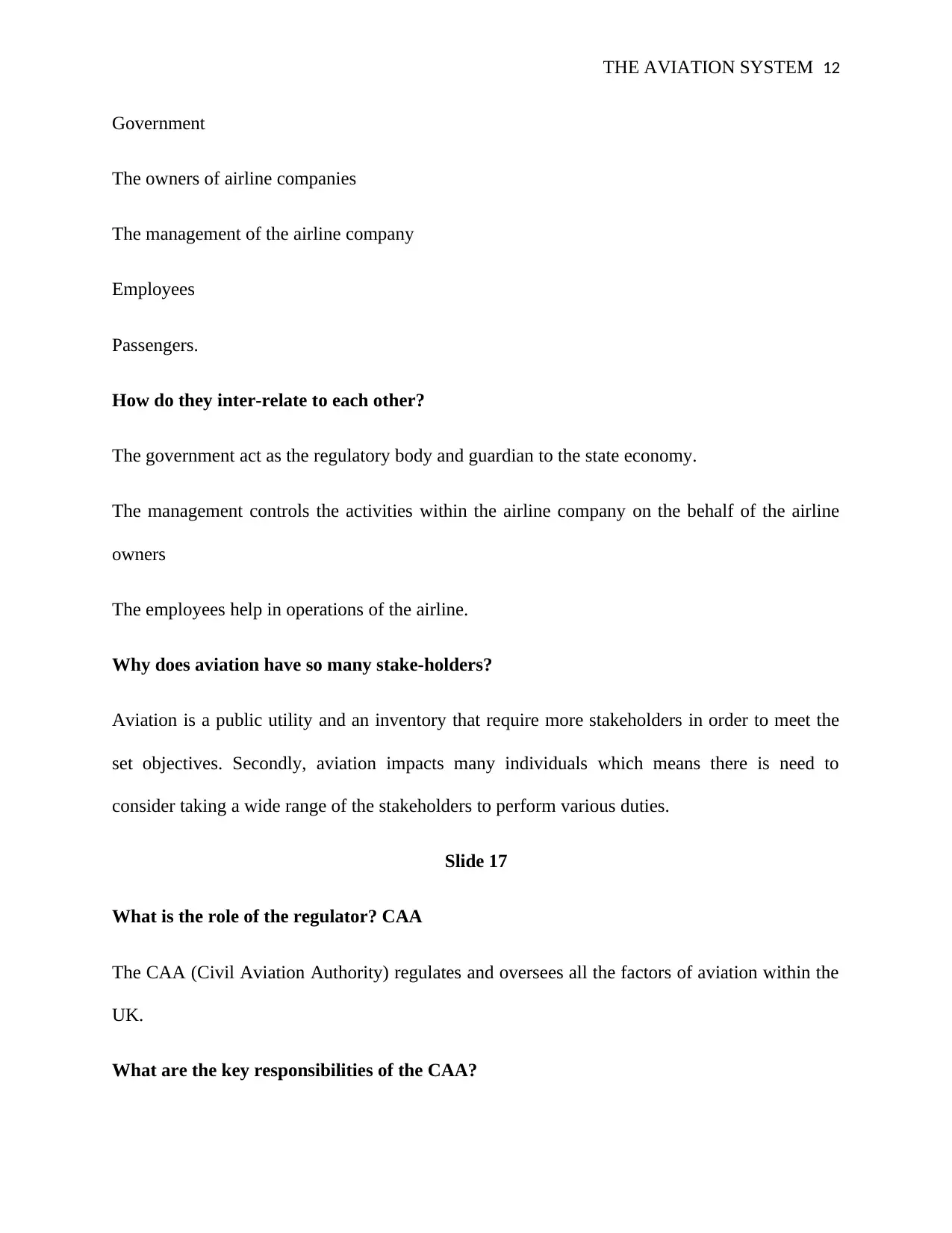
THE AVIATION SYSTEM 12
Government
The owners of airline companies
The management of the airline company
Employees
Passengers.
How do they inter-relate to each other?
The government act as the regulatory body and guardian to the state economy.
The management controls the activities within the airline company on the behalf of the airline
owners
The employees help in operations of the airline.
Why does aviation have so many stake-holders?
Aviation is a public utility and an inventory that require more stakeholders in order to meet the
set objectives. Secondly, aviation impacts many individuals which means there is need to
consider taking a wide range of the stakeholders to perform various duties.
Slide 17
What is the role of the regulator? CAA
The CAA (Civil Aviation Authority) regulates and oversees all the factors of aviation within the
UK.
What are the key responsibilities of the CAA?
Government
The owners of airline companies
The management of the airline company
Employees
Passengers.
How do they inter-relate to each other?
The government act as the regulatory body and guardian to the state economy.
The management controls the activities within the airline company on the behalf of the airline
owners
The employees help in operations of the airline.
Why does aviation have so many stake-holders?
Aviation is a public utility and an inventory that require more stakeholders in order to meet the
set objectives. Secondly, aviation impacts many individuals which means there is need to
consider taking a wide range of the stakeholders to perform various duties.
Slide 17
What is the role of the regulator? CAA
The CAA (Civil Aviation Authority) regulates and oversees all the factors of aviation within the
UK.
What are the key responsibilities of the CAA?
⊘ This is a preview!⊘
Do you want full access?
Subscribe today to unlock all pages.

Trusted by 1+ million students worldwide
1 out of 15
Related Documents
Your All-in-One AI-Powered Toolkit for Academic Success.
+13062052269
info@desklib.com
Available 24*7 on WhatsApp / Email
![[object Object]](/_next/static/media/star-bottom.7253800d.svg)
Unlock your academic potential
Copyright © 2020–2025 A2Z Services. All Rights Reserved. Developed and managed by ZUCOL.




